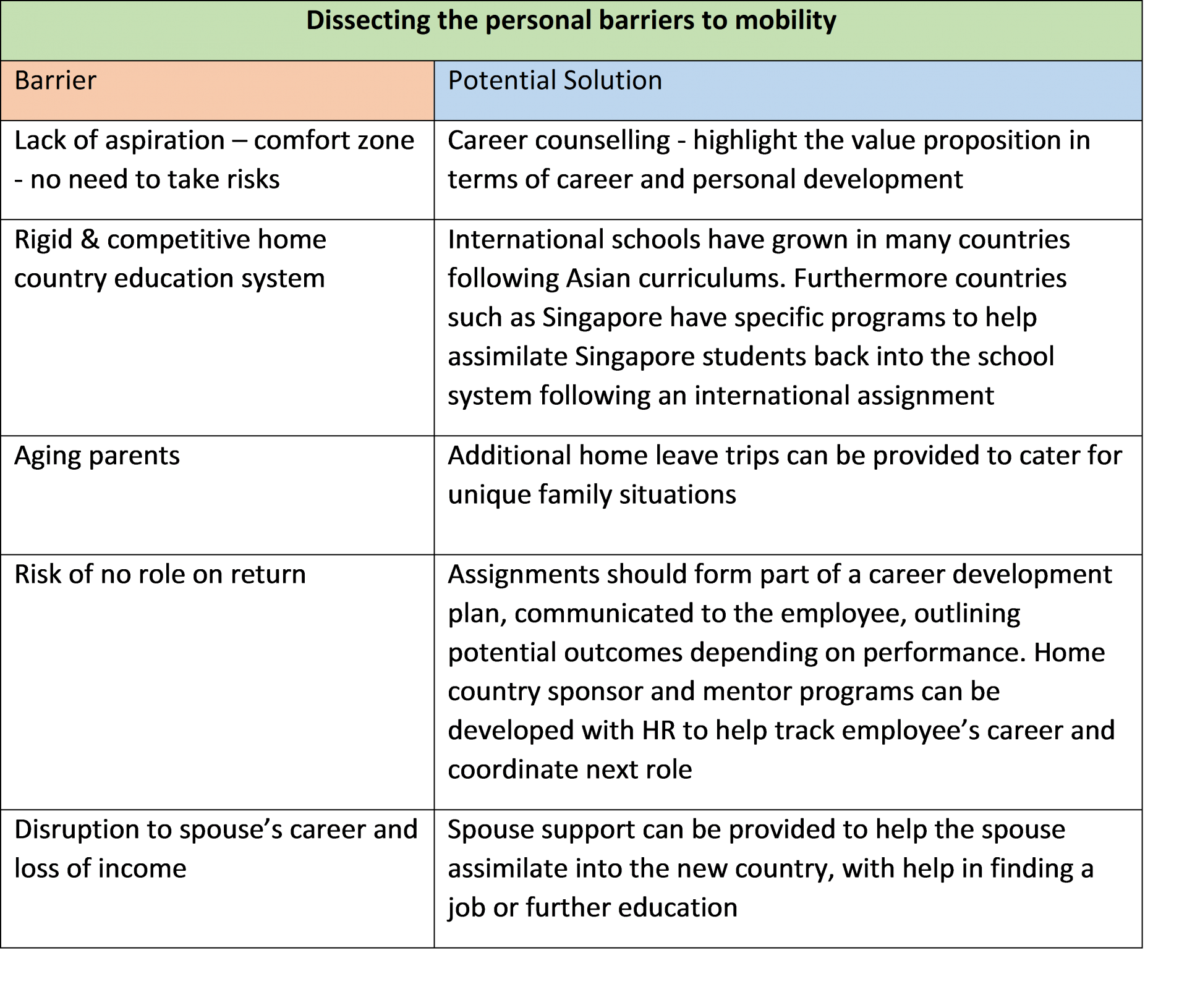The demand for skilled leadership talent in Asia continues to increase, however many companies struggle to fill their local leadership pipelines in the region, resulting in a continued reliance on imported foreign talent to take on executive leadership roles. A 2012 report by Mercer on Asia Pacific leadership development practices found that only 20 percent of companies in the region have locals in all top leadership positions. Compare that to a report by McKinsey Global Institute which predicts that 45 percent of Global Fortune 500 companies will come from emerging markets including Asia by 2025. The question remains, where are these leaders from Asia going to come from?
In this article we explore some of the strategies companies can use to develop their aspiring high potential leaders in Asia with the right skills and experiences to take on critical leadership roles and how the partnership of global mobility and talent management can play an integral part in driving the strategy.
Global-leadership competencies
Global-leadership competency models often emphasise a one-size-fits-all view of global leadership that is inconsistent with the reality of globalization and the diversity of work performed by global leaders, especially when considering the socio-economic and political landscape across Asia vs the West. A company may therefore find it useful to focus on a smaller set of key competencies across all of its global leaders, whilst allowing for customization to support the diversity of roles that fall under the broad category of global leadership. Generally global leaders need to be comfortable dealing with complexity and demonstrate stress & change tolerance, risk taking, openness & adaptability, catalytic learning agility and cultural awareness.
Cultural adaptability is a key competency, including the need to understand your own culture and lens and how you compare on a comparative cultural scale of competencies with other cultures impacting your workplace. Traditional Asian cultural values can often conflict with a dominant corporate culture, resulting in gaps on many levels that the employee and the company need to bridge.
The role of Talent Mobility
So how does global mobility play into developing these competencies? International exposure and cross cultural experiences will be essential to building the global skills and developing a global mind-set to achieve the right leadership competencies. Jay Conger highlights the role of mobility in The Practice of Leadership: Developing the Next Generation of Leaders, by stating “Mastery of cross cultural leadership competencies are progressive and cumulative. Global leaders identify the international assignment as the single most influential experience in their lives”. He elaborates further in his MIT Sloan Management Review, 2003 article with Douglas Ready, Why leadership development efforts fail, concluding executives learn leadership much more effectively from experiences than from educational courses, including on the job development, international assignments and cross group collaboration projects.
Short term (3-12 months) and long term (2-3 years) international assignments are the traditional mobility types used within organizations, however Global Mobility can also partner with HR to create formalized rotational programs to rotate employees through different roles and geographies, building breadth of experiences. Inter-cultural training, coaching and mentoring will be important elements of these mobility programs and would also be complimented by cross group and cross cultural collaboration projects and stretch international projects.
Long term assignments are the most effective method to build deep cross cultural global leadership competencies, as they allow the leader to become immersed in the culture and get involved in impactful business strategy, learning along the way.
Many companies however have been unable to link their talent mobility programs with the talent management strategy of the organization. This often leads to a wasted ROI in the global competencies gained on assignment as the programs are not part of a broader workforce planning approach, linking skills and leadership opportunities. Companies therefore need to have better talent and career management systems in place to ensure leadership developmental assignments are planned, meaningful and that returning assignees are progressing in their career and utilizing the newly attained global competencies and intercultural leadership skills. If not, companies will fail to retain their key leadership talent.
Case Study – building the leadership pipeline
One of the largest IT companies in the world, created a pioneering program in China, sponsored by corporate HQ, to help meet their talent needs of the future and build a pipeline of future leadership talent. The reliance on imported leadership talent from HQ and other Western and Asian developed countries was unsustainable and not a long term solution to building globally competent and locally savvy leaders. They focused on developing the leadership pipeline from the early career stage and developed an MBA immersion program. This involved recruiting the top Chinese talent from the best MBA schools around the world and placing them on a structured 18 month rotation program, the first 6 months in China, understanding the China business and strategy, the 2nd 6 months at their global HQ working with the global function leads and building global networks. The final rotation at an international subsidiary, learning how to apply the function’s strategies and operational plans, as well as understand best practices to implement back in China. Throughout the 18 month rotation teams work on a China business strategy project aligned to the China business priorities. A strong program foundation has been set up with toolkits for sponsors, mentors and rotation managers.
Barriers to Talent Mobility in Asia
Developing global leaders in Asia is dependent on emerging Asian leaders’ willingness to move internationally. This has been a challenge for many companies in Asia due to personal and social factors inhibiting employees to step outside their comfort zone and take the risk of an international posting. Strong family ties and very rigid education systems prevalent in many parts of Asia has often discouraged mobility or lead to the working partner (typically male) taking an assignment alone, leaving the family in the home country. There are certain ways that HR can provide customized support to alleviate some of the perceived barriers to mobility, however a fundamental shift in mind-set also needs to happen to highlight the value proposition of the international experience. The table below highlights some of the common personal barriers to mobility in Asia, along with some potential solutions to countering these perceptions.

In order to shift the emerging leader’s perception of risk it will be important to highlight the value proposition of international assignments (see table below). One of the most impactful ways to do this is through role models in the company. Successful Asian leaders who have been through global experiences can share their success stories and become role models for the next generation of aspiring leaders, encouraging risk taking and seeking out global careers. Seeing the face of a local or Asian Leader in the organization (as opposed to an expat) reinforces the notion of career development and the feeling that if one excels anything is possible, including the top job. This is a powerful recruiting and retention tool and removes the perception of a glass ceiling for local executives.

Summing up
As Asian economies continue to grow, aspiring leaders in this region have the opportunity to step up and take their rightful place in the global and regional leadership roles that will become available. It is widely accepted that to develop the global competencies necessary to be a successful global leader you will need diversified global experiences. This is supported by business leaders worldwide, such as the former CEO and current chairman of Nestle, who states that top leadership positions at Nestle are available for those who have lived and worked in several countries and speak several languages.
Companies will need to invest in intercultural training programs to enable managers to communicate and do business across cultures and also identify the global leadership competencies relevant to their business and leadership roles. HR should be partnering with global mobility to build the programs and policies to develop these leadership competencies and integrate this into their workforce planning strategy. Companies that formulate multiple developmental programs targeting early in career as well as mid-level managers and focussing on untapped talent pools such as female leaders will be able to build a strong pipeline of leadership candidates.
On an individual level aspiring global leaders must learn to take risks and instead of viewing the opportunity costs of an overseas assignment, look at the value proposition and the ROI in terms of career capital from the global leadership competencies developed as well as the life experiences for the family. If this happens then maybe by 2025 we will see Asian leaders filling the majority of leadership roles within the region and across the globe.


